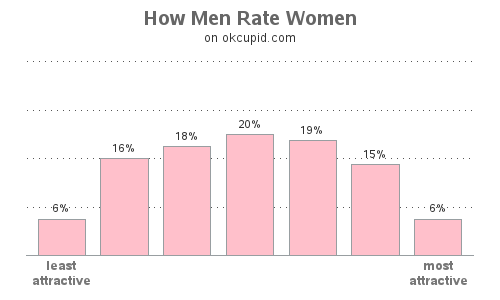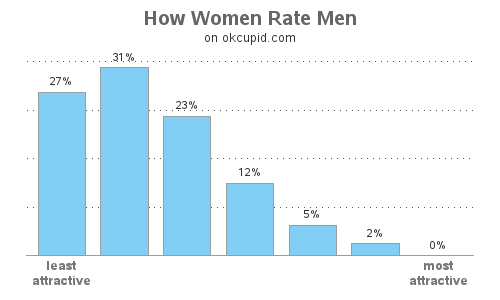I always recommend looking at data in several different ways, to get a more complete picture of what's really going on - such is the case with the member 'ratings' on dating websites. Let's take a look at some data from a different angle...
In a recent blog post, I analyzed which age men & women the opposite sex rated most attractive. The graphs indicated that men rated 20-year-old women the most attractive, whereas women rated men closer to their own age most attractive. This sparked quite a bit of discussion (such as the comments in the cross-posting of the blog on allanalytics.com).
So I decided to look at the ratings data in a different way - this time ignoring age, and just looking at how men and women rate each other in general. I found some histograms on p. 16 of Christian Rudder's new book Dataclysm that showed almost what I was looking for, and I then used some graphs from his blog to estimate the data so I could create similar charts in SAS.
Whereas the men of all age groups consistently rated 20-year-old women the most attractive (which produced a very lopsided chart), their ratings of all women in general produced a very symmetrical chart. In Rudder's book he even describes it as "close to what's called a symmetric beta distribution - a curve often deployed to model basic unbiased decisions." Therefore it appears that men are very unbiased/honest in the way they rate women.
By comparison, women rated men very poorly. Rudder mentions that women only rate one guy in six as "above average."
What causes this huge difference in how men and women rate each other? Is one being more honest than the other? Are they rating based on different criteria (perhaps men are rating based on looks, and women are rating based on whether or not they think the men would make a good mate)? Perhaps women are hesitant to rate a man highly, because they know that will trigger okcupid to send that man a message letting them know which woman rated them highly? What other factors are perhaps influencing this data?
Feel free to leave your thoughts & theories on this topic in the comments section!











20 Comments
Guys.... this is 100% just because women TRY way harder in their pics than men do. Makeup, hair, outfits, lighting, etc... men just put up a few pictures that make them look okay and show their hobbies. Men on dating sites are usually way more apt to be disappointed when meeting a woman in real life as well based on her looks. Women just put way more effort into their looks which can make people think that there are more attractive women then there are men, though it’s not necessarily true.
I do think tho that overall women will be more selective and less likely to be thrilled over an average looking guy. But an average looking girl with makeup and stuff, posing for a camera will make a guy likely think “oh she must be attractive”.
Maybe, the men on dating sites are less attractive in general than the women on dating sites or maybe, what you look for in the mother of your children is different from what you look for in the father and it’s possible that the guys on dating sites don’t have the confidence etc required for women to find them attractive.
Perhaps!
Could be, but then the same could be said of women.
*these* data. This is not that hard, man.
I guess there are different schools of thought on that :)
http://www.onlinegrammar.com.au/top-10-grammar-myths-data-is-plural-so-must-take-a-plural-verb/
https://en.wikipedia.org/wiki/Data_(word)
Women are biologically programmed to be more selective than men about who they will mate with. Given the enormous disparity between the number of children a woman can give birth to in her lifetime vs. the number of children a man can father, it makes perfect sense that men and women would evolve to have different mating strategies.
Hmmm...having been on dating sites recently and discussing the process with the men it is a different process for women then men. If a woman looks at any profile, you get a response. That can be quite full-on! You want to feel safe so behave differently than you would normally and only look at a few 'safe' profiles. Men do consider more women as an option than women consider men. They are open to more choice but, in the end, they tell me they tend to go for attractive women on the same wavelength as themselves.
If being safe was the issue we'd expect selectiveness, not lack of logic.
We would still see a bell curve, it's in matching we'd see the difference.
Rating 81% of people are bellow average, and as a collective (I expect some lack of reason from individuals, but crowds? So I can take 100 women, ask them how many bubble gums are in a glass jar, average the result and get pretty close, but I can't take 100 women ask where a group of men stand in the percentiles of attractiveness and average the results to get a close answer?)
There's a great video by Colttaine that discusses this, 'Gender Attraction Differential' https://www.youtube.com/watch?v=7vqRbScCIPU. Worth watching.
Rob,
There was a social study I heard recently on an interview that looked at women rating men and men rating women that found a difference in rating if the woman was taking birth control pills. Both genders were affected. It might have been in a Neuro biology article..
One thing I noticed on dating websites is that men, regardless of age, seem to be looking for someone younger (in some cases, a LOT younger), while women, regardless of age, seemed to be looking for someone their age, plus or minus a certain number of years. This is anecdotal evidence, so I'd be interested to see if a plot of gender, age, and age range of desired partner supports that.
One explanation would be that the men on OkCupid are not as attractive as the general male population. This would result if the men who use OkCupid are not a random sample from the general population but were a biased sample of less-attractive men who have trouble finding dates through traditional means.
Or perhaps the better-looking men quickly find dates, and then cancel their membership! :)
Looks to me, like an inverse correlation with male height distribution in the US.
really interesting graphs, when you start mixing up the values. love this!!!
Why the fascination with attractiveness? There are so many other things out there. Are they not represented in the data?
My plan is to start with some dating-website data that people can easily relate to (such as simple rating data), and if the blogs are well-received then move on to other dating-website data. Feel free to leave a comment with the kinds of data you'd like to see analyzed, and I'll keep an eye out for that data as a potential subject for future blogs! :)
Ha. Playing with actual data about dating could get very contentious/strident in the comments section very quickly. :)
I like the ratings-vs-messaging from the blog post. Those kind of mismatches are very interesting to my eye.
What about priorities for dataing selection (both stated and acual use)?
Do we have access to hard data?
I wish I had access to all the underlying data - but I only have access to what I can 'intuit' from the graphs and text in their blogs & book.